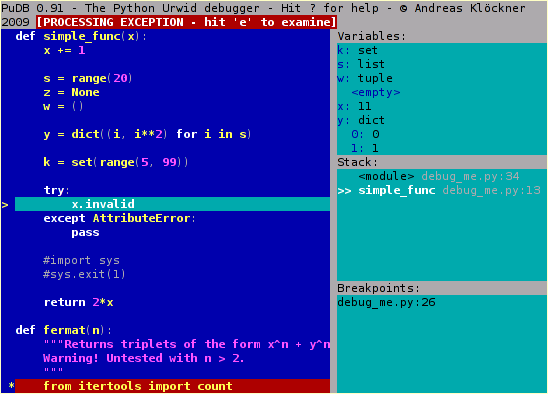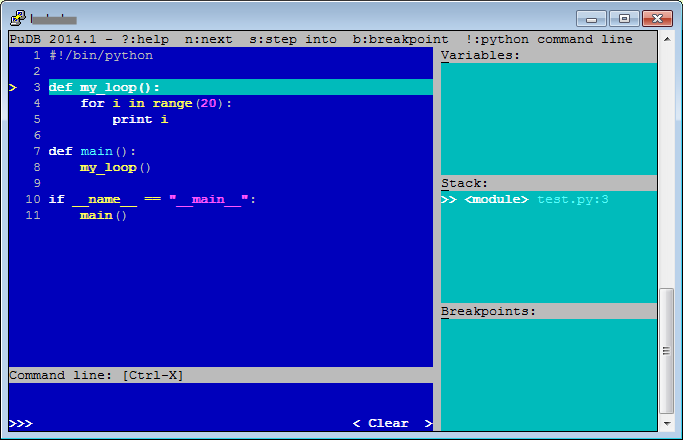The most basic way for debugging python would be to print variable information during the code execution, but we all know that this has some implications that make the rest of development a more sadistic process, as it introduces code that will have to be removed before the code goes to products.
Debugging live code can be improved by using breakpoints, calling the debugger within the code brings up a shell where you can use the debugger commands. Some of the tools I use are (you can install them with pip, package names are in parenthesis):
- Python Debugger (pdb) - https://docs.python.org/2/library/pdb.html (for python 2.x)
- IPython Debugger (ipdb) - https://pypi.python.org/pypi/ipdb
- PuDB (pudb) - https://pypi.python.org/pypi/pudb
The pdb and ipdb work are fairly similar, but the ipdb has some great features that come with ipython, such as autocomplete and highlights.
The most different here is the PuDB, that features some kind of a full UI for debugging, see the image bellow.

test.py
Now I wrote the following code the I need to step-by-step debug, so let’s use
each tool to check the values for i.
1
2
3
4
5
6
7
8
9
10
11
12
#!/bin/python
def my_loop():
for i in range(20):
import pdb; pdb.set_trace()
print i
def main():
my_loop()
if __name__ == "__main__":
main()
pdb
To create a breakpoint using pdb just past the following code:
import pdb; pdb.set_trace()
That puts us into the shell:
python test.py
> .../tmp/test.py(6)my_loop()
-> print i
(Pdb) _
Now if we enter ? and hit enter we can see the help for the documented commands.
(Pdb) ?
Documented commands (type help <topic>):
========================================
EOF bt cont enable jump pp run unt
a c continue exit l q s until
alias cl d h list quit step up
args clear debug help n r tbreak w
b commands disable ignore next restart u whatis
break condition down j p return unalias where
Miscellaneous help topics:
==========================
exec pdb
Undocumented commands:
======================
retval rv
One command that can save you when you are lost is the list command. It
basically prints the source code, for your current location, with a few lines
before and after.
(Pdb) list
1 #!/bin/python
2
3 def my_loop():
4 for i in range(20):
5 import pdb; pdb.set_trace()
6 -> print i
7
8 def main():
9 my_loop()
10
11 if __name__ == "__main__":
Basic usage commands:
corcontinueto go to the next break point (if there is no other break point it will finish execution);nornextwill go to next linesorstepwill make a “step into” kind of thinguorupwill “step up”
You can also call your script as argument for pdb, it will start it in the debugger where you can use all commands from the beginning of your script.
ipdb
ipdb is very similar to pdb but has all the cool features from the
ipython shell. From the start you will see, at least, better colors. It also
has the same commands as the pdb, so this is just a matter of test, or
project limitations. You can always enter help in the command line to get a
more detailed list of the “documented” commands.
PuDB
Let’s start our script from command line with pudb by calling pudb test.py.

You can see that it opens a really nice and busy view of the code we are in. You can call help by typing “?”. The hotkeys n, s, c and u have the same meaning, so it feels like home.
One cool thing you can do with this that is easier in PuDB is that by hitting
b you can set a break point where the cursor is. You can also call <ctrl>+p
to edit your preferences. Even set the default python shell to ipython, if you
want.
To call it, as a breakpoint, from within your code, you can paste the line bellow where you want it to pause execution and bring up the interface.
from pudb import set_trace; set_trace()
Celery Remote Debugging
For the lack of a better place to add this note, and as this is also debugging. The documentation is at http://celery.readthedocs.org/en/latest/tutorials/debugging.html.
To remote debug celery tasks you basically open give rdb a port, then you can connect with telnet.
from celery.contrib import rdb
rdb = rdb.Rdb(port=6899, port_search_limit=100, port_skew=0)
rdb.set_trace() # set breakpoint
